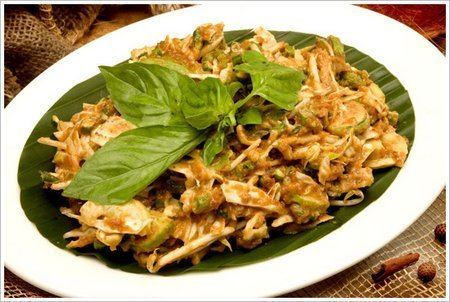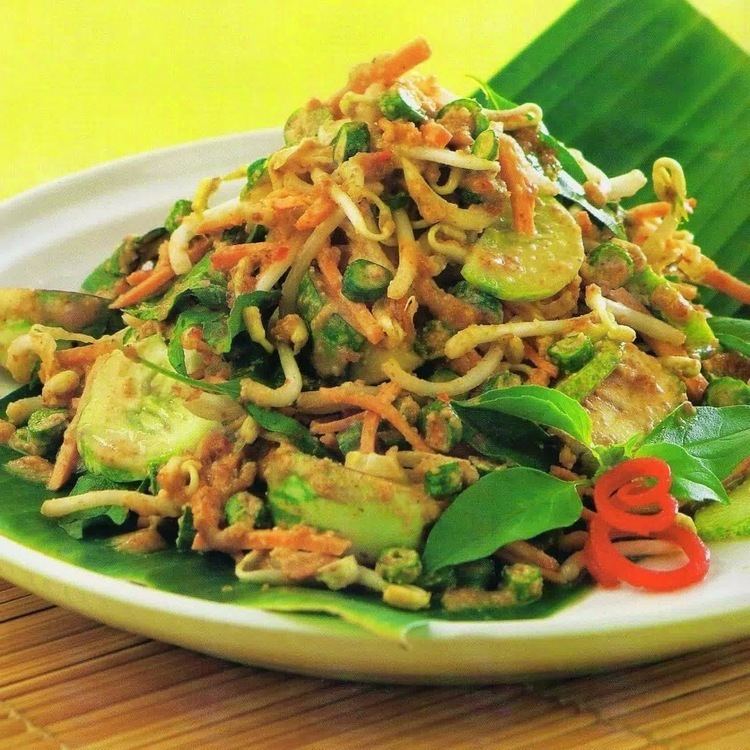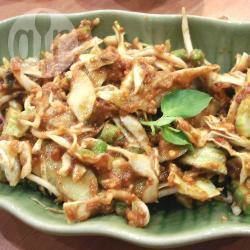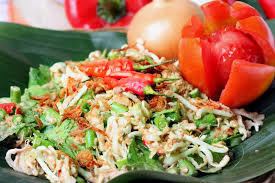Variation Gado-gado | Serving temperature Room temperature | |
 | ||
Similar Gado‑gado, Vegetable, Sayur asem, Pecel, Nasi timbel | ||
Indonesian food 01 karedok
Karedok is a raw vegetable salad in peanut sauce from West Java, Indonesia. It is one of the Sundanese signature dish. It originally included cucumbers, bean sprouts, cabbage, legumes, Thai basil, and small green eggplant, covered in peanut sauce dressing, but there are now many variations. It is very similar to gado-gado, except all the vegetables are raw, while most of gado-gado vegetables are boiled, and it uses kencur, Thai basil and eggplant. Karedok is also known as lotek atah (raw lotek or raw gado-gado) for its fresh and raw version of the vegetable covered with peanut sauce. Karedok is widely served as daily food in the Sundanese family, usually eaten with hot rice, tofu, tempeh and krupuk. Nowadays karedok can be found in many variation from hawkers carts, stalls (warung) as well as in restaurants and hotels both in Indonesia and worldwide.
Contents

Karedok is part of a wide range of Indonesian dressing and salad combinations, along with lotek, pecel and gado-gado. In many places, to retain authenticity in both the production and flavor, the peanut sauce is made in individual batches, in front of the customers. However, since the dish has gained popularity (because of the increase of Asian-themed restaurants) Karedok sauce is now mostly made ahead of time and cooked in bulk, although this is probably more common in Western restaurants rather than in Indonesia. Nowadays in supermarket and stores, many peanut seasoning for karedok are made and sold.
A dressing for this salad may include:
Variations

Over time, there has been a lot of variation in the garnishes used in karedok and its taste, but it is still basically vegetables covered in peanut seasoning.
Serves 4 people
Vegetables
Sauce

Garnish

- Parboil beansprouts and string beans.
- Slice cucumber, cut string beans into 3 cm pieces, and chop cabbage leaves into pieces.
- Grind red chilies, garlic, small chilies, kencur, peanuts, palm sugar, salt shrimp paste and vinegar in a blender.
- Add tamarind juice and hot water into 3 and mix until smooth.
- Mix all the vegetables and
- Serves with fried krupuk or emping on top.
Peanut sauce dressing

What distinguishes karedok from a plain vegetable salad is the peanut sauce dressing, which is poured on top of the vegetable salad before serving. The composition of this peanut sauce varies from commonly used peanuts kacang tanah (Indonesian).
Karedok is always served with crackers, usually krupuk commonly made from tapioca crackers or with emping crackers which are made from melinjo. In Indonesia, karedok is also usually served with rice or lontong (rice wrapped in banana leaf).
